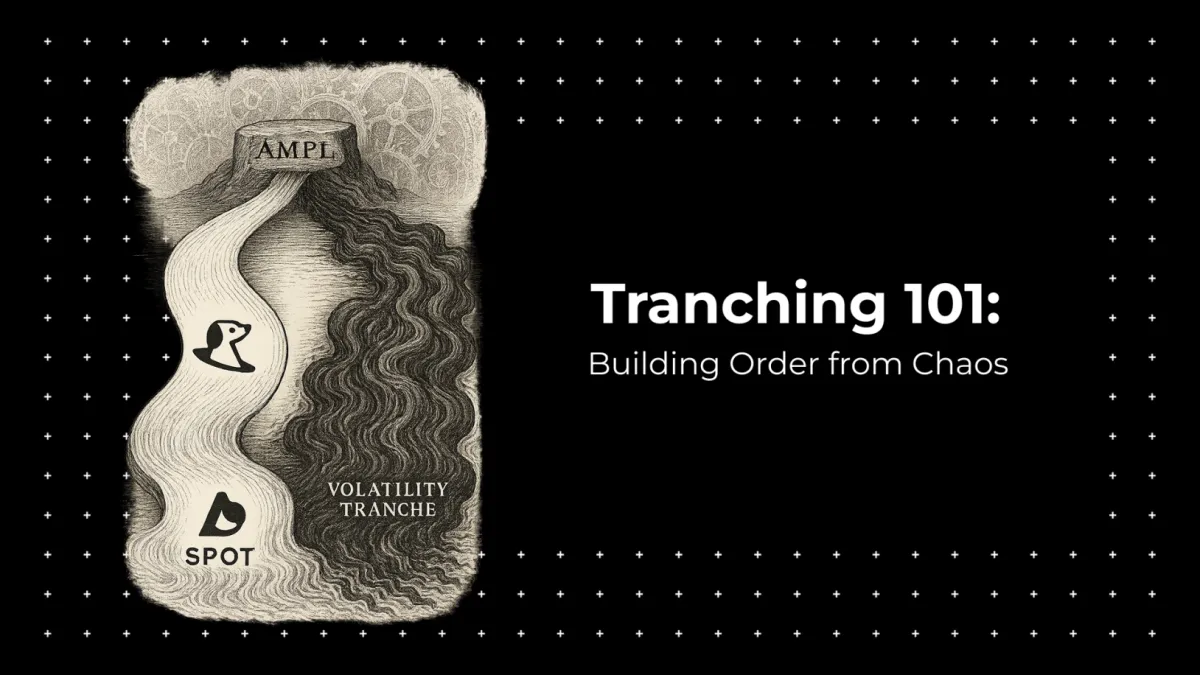Tranching 101: The Art of Engineering Stability from Volatility

I. Introduction
Volatility is the roller coaster of the investing world — full of ups and downs, twists and turns, and moments that rattle even seasoned riders. But in the markets, as on the tracks, those who stay strapped in are the ones who make it through. Timing the end of the ride is what separates skilled investors from the rest — and it's this challenge that keeps portfolios in flux and traders on edge, whether in traditional finance or the wild frontier of DeFi.
But what if volatility could actually be utilized, as a feature and not a bug? Enter Tranching: A powerful tool to segment assets into different risk-return profiles, offering new forms of investment customizability.
II. A Primer: Tranching in Traditional Finance
At its core, tranching is a mechanism to slice financial products into segments (or tranches) with different levels of risk, yield, and time to maturity. Investors gain advantages because they can select investment vehicles that match their risk tolerance yet remain exposed to identical underlying assets. The financial industry adopted tranching as a standard practice for structured finance products including mortgage-backed securities (MBS) and collateralized debt obligations (CDOs). Large asset or debt pools get divided into segments which present varying levels of risk and return potential.
Senior tranches carry the lowest risk and generate the lowest returns but junior tranches have lower risk exposure and therefore provide lower return expectations. The payment order in case of default follows senior tranches first and junior tranches last. This cash flows organization creates a flexible system which accommodates both conservative and aggressive investors. It provides investors with tailored risk-return profiles based on their investment preferences while maintaining consistent exposure to the same underlying asset.
Tranching offers customized risk-return profiles to different investor appetites, while making sure that exposure is always in regards to the same underlying asset.
III. Tranching in DeFi: A New Frontier
Crypto markets are defined by their extreme volatility. Prices swing wildly — from euphoric booms to crushing busts — and when the downturn hits, it’s not just valuations that fall. What follows is drying up of liquidity, yield diminishing, and ultimately capital fleeing the onchain economy. This triggers a vicious feedback loop: lower liquidity leads to lower yields, which drives even more capital out, deepening and prolonging the bear cycle.
The opportunity is clear: traditional tranching mechanics could transform the onchain investing environment significantly by creating yield, stability, or leverage from otherwise volatile assets. Such products could effectively end the vicious feedback loop observed in previous bear markets by incentivizing the retention of capital onchain.
Buttonwood became one of the first protocols to develop onchain mechanics for fixed-term tranching of rebasing tokens. While the junior tranches absorb the rebases, the senior tranches are shielded from any supply changes of the underlying asset. After maturation, the tranches turn back into the underlying asset.
IV. Ampleforth’s Volatility Challenge
The Ampleforth protocol has changed the volatility landscape of crypto assets by introducing a mechanism that shifts price volatility to supply volatility on a daily basis. Specifically, AMPL’s supply is readjusted (rebasing) every 24 hours to bring back its market price to target - the 2019 CPI-adjusted US dollar. The elastic supply policy targets stable purchasing power rather than price.
One could ask how this approach solves the volatility problem of the crypto market, and honestly, it doesn’t. Not on its own. In its normal operation mode AMPL only reorders volatility, it does not create or destroy it in any way. However, if coupled with an onchain tranching mechanism, AMPL’s volatility shuffling becomes a powerful tool to create stability and leverage at the same time.
V. The SPOT + Tranching Solution
This is where Ampleforth’s SPOT token comes in. SPOT is created by an onchain tranching operation using AMPL as the underlying asset.
AMPL is divided into two types of tranches: 1) the junior tranches which carry majority of the risk by absorbing AMPL supply volatility first, and 2) the senior tranches which are greatly shielded against AMPL rebases.
The tranching operation creates assets (junior and senior), which inherit some of AMPLs characteristics, such as long-term price-stability (in terms of CPI), while on the other hand also being supply stable. Different vintages (tranches of varying maturity dates) make bundling necessary (see rotation vault) to create fungible products with unique properties: SPOT and stAMPL.
SPOT is a proportional claim on a basket of senior AMPL tranches. It therefore acts as a low-volatility derivative of AMPL - without any price pegs or rebases.
stAMPL is a proportional claim on a basket of junior AMPL tranches. It therefore acts as a high-volatility (leveraged) derivative of AMPL.
Through the tranching operation, two new assets with different characteristics but exposure to the same underlying asset (AMPL) are created. If it is demand for stability (SPOT) or demand for AMPL leverage (stAMPL), both investing strategies are ultimately served.
VI. Why This Matters
As of now, the crypto asset landscape mostly knows two asset classes: full-risk on assets with crazy volatility levels (BTC, ETH, alts) or stablecoins without any volatility (USDC, USDT, DAI). Low-volatility assets are scarce, even though they would serve as a perfect retreat during risk-off periods, keeping liquidity onchain while avoiding long, deep bear markets. Onchain tranching comes in as a perfect solution, aiming to create low- and high-volatility derivatives without requiring pegs, real-time price feed oracle, or introducing any custodial risks.
VII. Conclusion
Tranching is a time-tested tool from structured finance for tailoring risk to different investor appetites. The Ampleforth protocol repurposes it for DeFi in a novel way. The operation leads to the creation of low- and high-volatility assets, ultimately transforming crypto’s “zero or one” binary volatility class profiles into a fully populated spectrum, meeting different investing strategy demands - during bull and especially bear markets.




